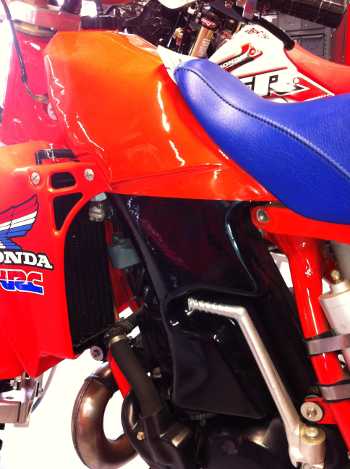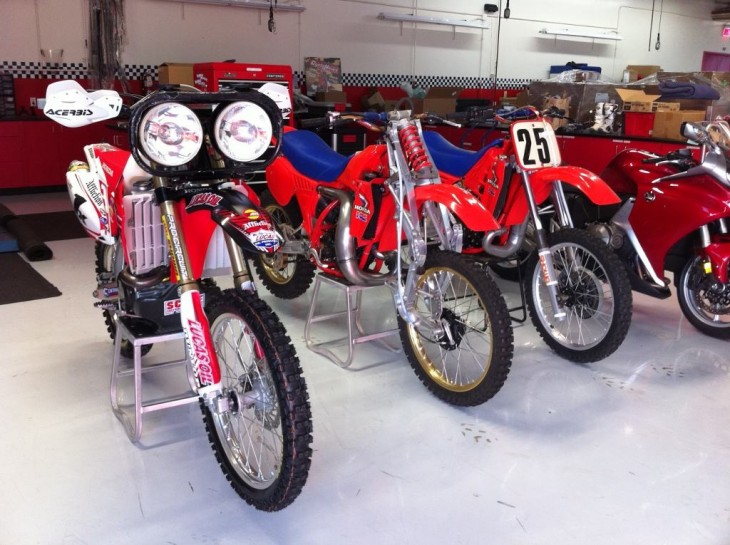
Delicate-looking front end was invented by Valentino Ribi. It worked well enough, but Honda decided it was too expensive for production machinery.
While visiting American Honda’s HQ for the CBR250R product introduction, my eagle-like reporter’s eyes spotted a couple of interesting-looking dirtbikes parked in the large raceshop/press fleet garage. I asked American Honda’s Jon Seidel for permission to photograph them, expecting to be politely shot down (industry legend* holds that Seidel’s great-uncle, a WWII Army Air Force pilot who destroyed 11 Nazi aircraft over Italy, would send a Hickory Farms gift basket to Hermann Goering every time he downed one of his planes), but instead, he called over Ray Conway, American Honda’s Motorcycle Sports Director (who of course was just conveniently lounging around the race shop) to tell me about the bikes.
It turns out they were in the garage because they had been trundled out of American Honda’s collection to show off for some event or other. The first machine that caught my eye was the bike with the weird alternative front suspension and huge, low-hanging fuel tank. Some alternative prototype that never made it to market? No. This machine is a bitsa composed of many components from several racebikes, and was never raced by anybody.

Intricate aluminum swingarm features an adjustable torque arm and linkage to combat rear-end movement under hard braking. Note mount on opposite side so both left and right-hand chain-drive motors can be accommodated.

Beautiful hand-made aluminum fuel tank puts most of the gas below the cylinder head, keeping weight lower for better handling. One article I read reported that each one of these bikes cost over $200,000 each, about $400,000 in today's money, which tells you why the AMA moved to production rules.
But the bits on it did see battle. The intricate-looking front end is one of two variations of the design Valentino Ribi patented (the other uses two shocks mounted just above the wheel) in 1980. The complex device lessened the effects of brake dive and bump absorption on a bike’s steering geometry, and worked so well that motocross Godfather Roger Decoster persuaded Honda to buy the design when he defected to Honda from Suzuki, and American Honda even tested it on some streetbikes. But it was too expensive for production use, so it was shelved. Also of note is the fuel-pump-equipped aluminum gas tank, trick rear swingarm with adjustable torque arm and mounts on both sides so it could be used on left and right chain drives, as well as the liquid-cooled two-stroke motor, devoid of any markings other than a tiny, enigmatic “12-SX” stamped into the case.
The other bike was raced by Bob Hannah in its present configuration. It’s equipped with 47mm magnesium forks. The full-works 250 motor is probably an ’83, says Conway.
That’s a lot of history to absorb in 20 minutes, but it gets me pondering deeper issues. American Honda and the other large OEMs have the resources to preserve their industrial heritage, but think of all the interesting and historical machines that are parted out, destroyed or just quietly rust away each year. I’m glad I got to see these two little slices of history.
*But this is obviously untrue, as Hickory Farms wasn’t in business until 1951.








Some of the “variable offset” traits of the Ribi front end were actually desirable..I remember Roger saying he preferred it on standard outdoor circuits…but he/they shelved it when it became too difficult to match the spring and damping rates to super cross style doubles and triples…and still maintain compliance in other places on a given circuit..
Honda has saved a few:
http://world.honda.com/collection-hall/
Their museum, the Honda Collection at TwinRing Motegi. Neat stuff, and interesting inasmuch as Honda does have notable competitors’ machines as well.
MAN would I love to go there someday.
Randy Singer is right about this front-end design being a variation on the leading-link design that had been around for many decades. The reason this design did not make it to production probably did not have much to do with cost, since the total complexity is less than for a conventional fork. In fact simplicity is one notable advantage. There are some mechanical advantages over conventional forks, but there are also significant mechanical disadvantages. The reason that leading and trailing link front suspensions have never been popular in the mainstream is due to the mechanical disadvantages. In most leading link and trailing link designs, the wheel axle moves in a tight arc, which means that the contact patch moves fore and aft quite far with the suspension travel. This causes the amount of front wheel trail to vary excessively as the wheel moves up and down, which of course means that the sensitivity and quickness of the steering varies appreciably. To preclude the possibility of the front wheel trail going to zero and becoming negative, in which case the steering would become abruptly unstable and would turn fully to one side causing a crash, the nominal amount of trail has to be made somewhat greater than the amount that is ideal for balancing responsiveness with stability. Additionally, the inertia about the steering axis is increased, relative to a conventional sliding fork, due mainly to the heavy U-shaped horizontal member that wraps around the rear of the wheel. Not all leading-link designs have this feature, but if the links are not joined in this wrap-around manner, then they needed amount of stiffness has to be accomplished by making the beefier, which also adds mass and inertia about the steering axis. Sliding forks are preferred in commercial, mass-marketed motorcycles for reasons that have nothing to do with cost. It is because that in the final analysis, they are superior to just about everything else. The alternate front suspensions that BMW uses are the notable exceptions. Both of BMW’s non-conventional front suspension designs have certain advantages. Neither of those designs uses a leading or trailing link, but they both also have quirks. With Duolever, the line through the upper and lower ball joints on the fork do not stay perfectly aligned with the steering spindle above. This effect is avoided in Telelever, but the fore/aft and vertical location of the steering changes by a slight amount as the suspension compresses and expands.
Actually the Ribi Quadrilateral fork was designed to retain the steering characteristics of a telescopic fork while seperating braking from suspension and steering movement. Roger D was so impressed with the Ribi design from his experience with it on his works Suzuki that when he moved to Honda he convinced the factory to purchase the rights.
Would love to see a comparo between one of these works bikes (dirt and road race) and a modern production version. These sorts of sneak peeks into the not-so-distant past are a real reminder of just how advanced a product we regular folk can buy. Thanks for a great look back.
I love seeing this kind of future thinking machinery, even if it never made it to production. I remember seeing a 1000cc v-twin sport bike from Yamaha in what amounted to be a closet off the race shop….it was very aggressive looking. This was back before the RC-51 when the Japanese manufacturers were scratching their heads trying to overcome Ducatis dominance in WSB.
On a side note, Jon Seidel is one of the great ambassadors of this industry. I was lucky enough to count him as a friend many years ago and I’ll never forget his passion for riding. He once rode a V-Max ( if memory serves ) into the Honda tent at Daytona and answered inquisitive stares with something to the effect of “it’s a musclebike, we don’t make one, when we do, I’ll ride it”. Classic!!
I remember reading of journalists getting a peek or two behind previously closed doors at Honda in Japan and seen racks and racks of non-standard pieces. Such as varying sizes of “oval” pistons that didn’t seem to be from any known race bikes. I think Honda in particular because of their size and engineering background is especially interesting. I remember as a kid submitting some ideas to them when I was a teenager which they ackowledged until one day I got a polite note from their legal arm in L.A.!
Hannah certainly was one tough customer. Imagine having to bump start that thing out of the starting gate!
DeCoster used the Ribi front fork on his works Suzuki the last year he raced for them and it was used on his works Honda a few times his last year racing.
Looks like a variation of the leading link suspension that has been seen on motorcycles for well over half a century. Especially motorcycles with sidecars; and Greeves, DKW, Sachs and other off-road motorcycles:
http://scray.smugmug.com/Motorcycles/Leighs-w/DRz-400-LH-leading-link/646442380_GAgyj-L.jpg
Yes.
Just imagine what has been thought of, designed, built, tested, dismissed and discarded. Bet there was some neat stuff.
And maybe it is time to dust off some of those ideas… Maybe?